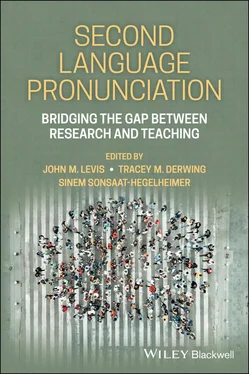Second Language Pronunciation
Здесь есть возможность читать онлайн «Second Language Pronunciation» — ознакомительный отрывок электронной книги совершенно бесплатно, а после прочтения отрывка купить полную версию. В некоторых случаях можно слушать аудио, скачать через торрент в формате fb2 и присутствует краткое содержание. Жанр: unrecognised, на английском языке. Описание произведения, (предисловие) а так же отзывы посетителей доступны на портале библиотеки ЛибКат.
- Название:Second Language Pronunciation
- Автор:
- Жанр:
- Год:неизвестен
- ISBN:нет данных
- Рейтинг книги:5 / 5. Голосов: 1
-
Избранное:Добавить в избранное
- Отзывы:
-
Ваша оценка:
- 100
- 1
- 2
- 3
- 4
- 5
Second Language Pronunciation: краткое содержание, описание и аннотация
Предлагаем к чтению аннотацию, описание, краткое содержание или предисловие (зависит от того, что написал сам автор книги «Second Language Pronunciation»). Если вы не нашли необходимую информацию о книге — напишите в комментариях, мы постараемся отыскать её.
Second Language Pronunciation: Bridging the Gap Between Research and Teaching
Second Language Pronunciation: Bridging the Gap Between Research and Teaching
Second Language Pronunciation — читать онлайн ознакомительный отрывок
Ниже представлен текст книги, разбитый по страницам. Система сохранения места последней прочитанной страницы, позволяет с удобством читать онлайн бесплатно книгу «Second Language Pronunciation», без необходимости каждый раз заново искать на чём Вы остановились. Поставьте закладку, и сможете в любой момент перейти на страницу, на которой закончили чтение.
Интервал:
Закладка:
1 Record each student’s speech for 30 seconds or more. Alternatively, have groups of students work together doing some type of speaking or pronunciation task. This can allow more efficient diagnosis. A voice recording is sufficient, but a video recording will enable evaluation of physical movements during speech. For more advanced learners, this might result in 2–3 minutes; for low-level learners, try for at least 30 seconds. Recording can come from an interview or a monolog such as “my favorite holiday celebration.” (We do not encourage the use of reading aloud for literacy-level learners. Navigating the spelling-sound interface will lead to many errors that do not show up in free speech.)
2 Listen to each recording, then name and evaluate the most prominent errors.
3 Evaluate the main errors that are true for each student and for the class overall. A possible rubric is provided below.
| Pronunciation Features | Holistic Scale | Errors Noticed (possible examples) | ||||
|---|---|---|---|---|---|---|
| Vowel sounds | 1 | 2 | 3 | 4 | 5 | “hit” sounds like heat “man” and “men” similar |
| Few errors | Many errors | |||||
| Consonant sounds | 1 | 2 | 3 | 4 | 5 | Initial consonants are mostly clear. Often deletes final consonants |
| Few errors | Many errors | |||||
| Voice Quality Settings | 1 | 2 | 3 | 4 | 5 | Minimal lip and jaw movement |
| Few errors | Many errors | |||||
| Thought groups | 1 | 2 | 3 | 4 | 5 | Phrases are usually very short or very long |
| Logical phrases | Phrases too short or long | |||||
| Word stress | 1 | 2 | 3 | 4 | 5 | Longer words have no clear stress |
| Correct stress | Unclear emphasis | |||||
| Intonation | 1 | 2 | 3 | 4 | 5 | Pitch sounds monotone. Not easy to know where sentences end. |
| Pitch rises & falls | Pitch flat or confusing | |||||
| Overall Fluency | 1 | 2 | 3 | 4 | 5 | A lot of silent pauses |
| Speaks smoothly | Speaks haltingly |
3 Perception in Pronunciation Training
Ron I. Thomson
Brock University
When my son Elliot was a toddler, he would proudly let people know that his name was “Elliort” [ɛlijɝt]. This went on for many months until one day, for posterity, I recorded him in the following exchange:
DADDY: What’s your name?
SON: Elliort
DADDY: Elliort?
SON: No! Elliort!
DADDY: Okay, Elliort.
SON: ( laughing ) DAUGHTER: ( interrupting ) Elliot! SON: Elliot DAUGHTER: Elliot SON: Yeah, Elliot. ( after several more such exchanges ) DADDY: Elliot? SON: Yes. DADDY: Say it. SON: Elliort
Without the benefit of further modeling from his preschool sister, my perceptual gaslighting continued and he continued saying “Elliort,” despite the fact that by this point he clearly perceived his own pronunciation to be incorrect. Curiously, within a couple of days, he began accurately pronouncing his name without any difficulty, and he never went back to calling himself “Elliort.” This anecdote powerfully illustrates the interaction between speech perception and production in the development of first language (L1) pronunciation. Elliot could clearly recognize the difference between accurate and inaccurate productions of his name, but he could not perfectly produce it himself. Nor had he previously appeared to notice the mismatch between his own pronunciation and how he perceived others to say his name. This demonstrates that conscious noticing during speech learning can trigger a sudden change in what seemed to be a well-established mispronunciation. It also reveals the importance of input from varied interlocutors, since Elliot was able to accurately imitate his sister’s model, but not my own pronunciation. This was probably not an accident, since her vocal tract size and shape were nearly identical to his own. In learning to accurately perceive phonetic cues associated with particular sounds and words, humans must also learn to normalize what they hear relative to the size and shape of each speaker’s vocal tract (Johnson & Sjerps, 2021). As I will make clear, a similar lag between perception and production is also a feature of second language (L2) pronunciation learning. Furthermore, conscious attention and input from a variety of speakers are important to L2 pronunciation development as well.
In this chapter, I describe how typical L1 pronunciation develops, and apply this knowledge to identifying both similarities and fundamental differences in L2 pronunciation learning. I then discuss critical evidence supporting the benefit of perception-oriented training for L2 pronunciation. Finally, I describe practical implications for pronunciation instruction and recommend perceptually focused resources for teaching and research. For the purpose of this chapter, speech perception refers to the cognitive process by which sounds are heard and categorized. This contrasts with speech production , which refers to the output of the cognitive system, mediated by physical control of speech gestures. Pronunciation is an umbrella term capturing both perception and production processes. I primarily focus on the perception of segments, for which there is a far greater literature, but some of the same principles may extend to suprasegmentals as well.
L1 pronunciation
The development of L1 speech perception begins in utero, evidence for which is manifested immediately after birth (Zhao & Kuhl, 2018). Researchers have used laboratory techniques to establish that within hours of birth, babies not only show a preference for their mother’s voice (Lee & Kisilevsky, 2014; May et al., 2018) but are also capable of distinguishing between L1 versus foreign language sounds (Moon et al., 2013). These abilities are hypothesized to result from fetal experience of the mother’s voice, and the voices of other speakers of the L1, through the abdominal wall.
Despite their proclivity toward speakers heard in utero, newborns maintain the ability to perceive fine-grained phonetic details associated with any speech sounds found in any of the world’s languages for some time after birth. By six months, however, experience with their ambient language (or languages) results in refinement of their perceptual systems, such that they begin paying less attention to any phonetic information not needed to categorize L1 speech sounds (Kuhl, 2009). By the time they are a year old, infants begin losing the ability to discriminate foreign speech sounds, while their ability to recognize ambient language sounds strengthens (Zhao & Kuhl, 2018). This loss of perceptual plasticity corresponds with increasing L1 processing efficiency, which is a necessary precursor to the learning of L1 vocabulary and higher-order language skills (Kuhl, 2009). By the time children reach the age of four, they cannot discriminate sounds in a foreign language any better than an adult can (Werker, 2018).
Extensive research describing L1 speech perception and later language development makes it clear that the foundation of L1 pronunciation is accurate speech perception, which results in automatic categorization of sounds (Werker & Curtin, 2005). Though lagging behind perception, the development of L1 speech production follows the same trajectory. As with perception, infant vocalizations first emerge in language-independent ways. By ten months, babbling begins to reflect the properties of the ambient language (Grenon et al., 2007). The observed asymmetry between L1 perception and production is in part due to physiology, since speaking is a physical activity, while perception is cognitive. Over time, the acoustic properties of L1 speech production begin to closely match that of older speakers in the community (Flege, 2003). Kuhl and Meltzoff (1996) argue that children’s vocal imitation of interlocutors explains how this happens, as was illustrated in the personal anecdote with which I began this chapter.
Читать дальшеИнтервал:
Закладка:
Похожие книги на «Second Language Pronunciation»
Представляем Вашему вниманию похожие книги на «Second Language Pronunciation» списком для выбора. Мы отобрали схожую по названию и смыслу литературу в надежде предоставить читателям больше вариантов отыскать новые, интересные, ещё непрочитанные произведения.
Обсуждение, отзывы о книге «Second Language Pronunciation» и просто собственные мнения читателей. Оставьте ваши комментарии, напишите, что Вы думаете о произведении, его смысле или главных героях. Укажите что конкретно понравилось, а что нет, и почему Вы так считаете.












